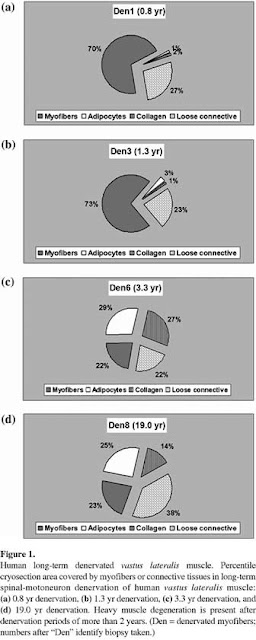Hello! And welcome to our blog. As physio students delving into the use of estim in different modalities, we have created this blog to answer this one question: Does estim affect denervated muscle?
Ok so you are probably wondering what that even means? What is denervated muscle?
Denervated muscle is muscle that is completely separated from nerve fibers, meaning it is getting no impulses from the Central Nervous System (CNS) or Peripheral Nervous System (PNS). Basically that means that the transmission of the impulses telling the muscles to contract or relax are not getting through most of the time or sometimes even at all, and the muscle is affected chronically, or long-term.
So what happens to a muscle when it is denervated?
The most common finding is that denervated muscle begins to atrophy. Depending on the size and location of injury and how long the muscle has been denervated, it may have atrophied completely, causing more difficulties with electrical stimulation.
An article we found very interesting by Goldspink et al, in a study done on rats, found that the weight of the muscle may drop by 50% after a month, which also associates with a loss in the diameter of the muscle fiber by more than 50%. Two things that are important to remember about this change though are that this study is done on rats. Equal loss in size in humans probably takes a month or two longer, and even can be variable from muscle to muscle. Also, the fibers still are regular with the same striations as at their full weight, but they do have a decreased numbers of myofibrils. After a year or so, the number of myofibrils is significantly reduced, and fat and connective tissue has filled much of what used to be muscle, which we think is significant because it will have less of a reaction to a surface electrode. The results of Goldspink’s study show that atrophy of denervated muscle seems to be due to the change in the activity pattern of the muscle, rather than just the lack of nerve supply for protein synthesis. Opposite to our first thoughts, we think this is important to note as we get more into how electric stimulation works because it means that there might be hope for the activity that the stimulation could put on the muscle. However, much of this depends on how long the muscle has been denervated for.
For visual stimulation, here is an example of the different amounts of myofibrils, connective tissue, adipocytes and collagen over time as the denervation takes place.
picture obtained from http://www.rehab.research.va.gov/jour/05/42/3suppl1/kern.html
For visual stimulation, here is an example of the different amounts of myofibrils, connective tissue, adipocytes and collagen over time as the denervation takes place.
picture obtained from http://www.rehab.research.va.gov/jour/05/42/3suppl1/kern.html
So the question is, does estim help with contraction, activation, or rebuilding of this chronically atrophied denervated muscle? As for what we have read so far, estim, over long periods of time, does have benefits. The studies we have looked at so far have all been done on rats or rabbits, and all point to increases in certain elements but not full recovery. But for now, we will let you wrap your head around that as we gather more research. In future posts we will get detailed on what type of stimulation is best, how to keep it safe, whether or not it can improve or prevent muscle atrophy, and whether or not the benefits outweigh the risks. Until next time!!
Team North America signing off -
-Megs and Brooke-
Reference:
Goldspink, G., Tabary, C. Tabary, J.C., Tardieu, C., Tardieu, G. (1973). Effect of Denervation on the Adaptation of Sarcomere Number and Muscle Extensibility to the Functional Length of the Muscle: Journal of Physiology. 236, 733-42.
Team North America signing off -
-Megs and Brooke-
Reference:
Goldspink, G., Tabary, C. Tabary, J.C., Tardieu, C., Tardieu, G. (1973). Effect of Denervation on the Adaptation of Sarcomere Number and Muscle Extensibility to the Functional Length of the Muscle: Journal of Physiology. 236, 733-42.

Good Work team North America. Firstly, since this is a public blog you should supply your references. A picture would add interest. Perhaps one illustrating the differences between denervated and normal muscle that you described so well in your text would be useful. I like your use of opinion in this piece. And, especially knowing that anyone might read it, it would be polite to remember that laypersons will not necessarily understand your acronmyms; so CNS and PNS should be in full first. Thanks CY
ReplyDeleteThanks for the most appropriate image, and the adjustments to acronyms - CY
ReplyDelete